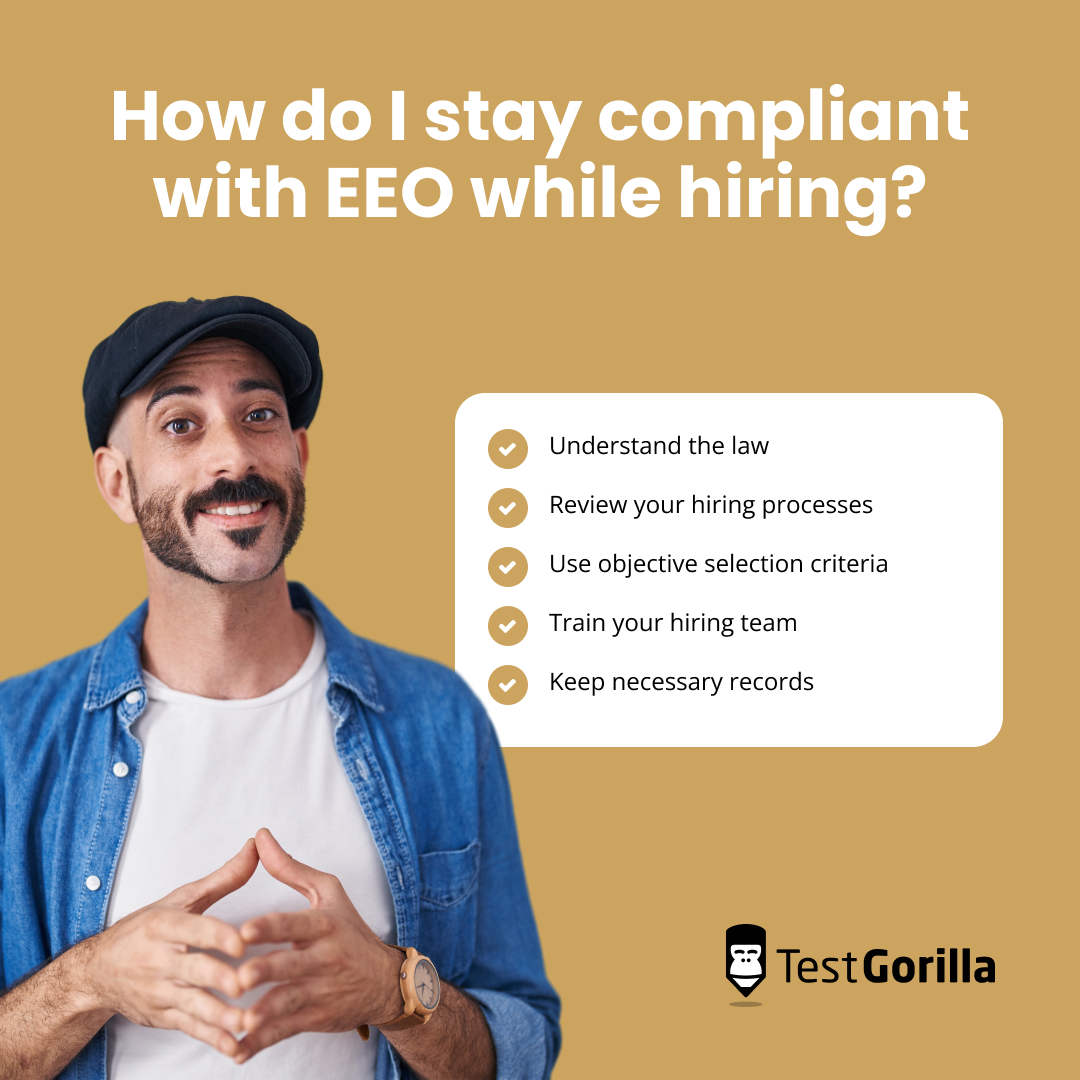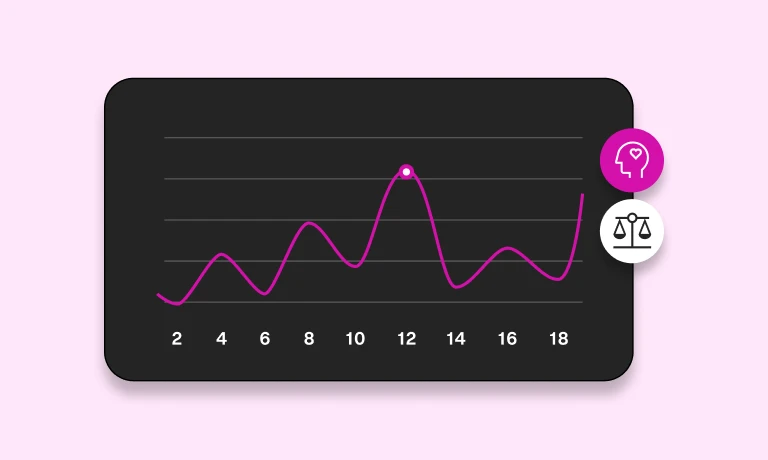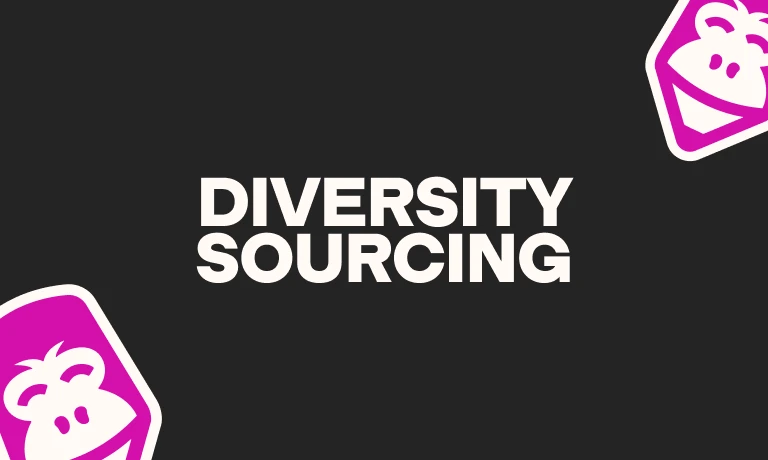Employer’s guide to Equal Employment Opportunity (EEO) and hiring
Various laws strive to ensure candidates have equal access to employment opportunities. Failing to understand or comply with these laws puts you at risk of formal investigations, remedial action, and lawsuits from candidates and government agencies.
However, compliance isn’t always easy. Federal, state, and local laws may apply to your business. And these laws are constantly changing.
In this article, we help you understand how equal employment opportunity (EEO) laws protect job applicants and what the consequences of non-compliance are.
We also suggest steps you can take to support compliance, reduce the risk of EEO violations, and create fair hiring practices.
Table of contents
- What are EEO laws, and why do they matter?
- What types of hiring discrimination does EEO cover?
- What happens if I break EEO laws during the hiring process?
- What should I do if I receive an EEO complaint from a job applicant?
- How do I stay compliant with EEO while hiring?
- How pre-employment testing supports EEO
What are EEO laws, and why do they matter?
EEO laws prohibit workplace discrimination, ensuring candidates and employees are treated fairly. They apply to all stages of the employment lifecycle, including recruitment and hiring.
In hiring, EEO laws require businesses to adopt fair and equal hiring practices. By ensuring everyone can participate in employment, they support workplace diversity.
How do EEO laws protect job applicants?
EEO anti-discrimination laws identify specific protected characteristics. An organization discriminating against a candidate because of one or more characteristics is violating the law and may face legal penalties.
Along with the Fair Labor Standards Act, EEO laws form part of the employment law landscape your business must navigate when hiring new employees. These laws exist at the federal, state, and local levels.
What types of hiring discrimination does EEO cover?
At a federal level, EEO laws prohibit discrimination based on protected characteristics, including:
Race
Color
National origin
Religion
Sex, including gender, pregnancy, and sexual orientation
Disability
Age (40 and older)
Genetic information, like genetic tests and family medical history
These laws apply to employers with 15 or more employees, except in cases of age discrimination, where the law applies to employers with 20 or more employees.
When they apply, EEO laws prohibit you from discriminating against candidates because of one or more of the protected characteristics listed above. For example, you can’t discriminate against a candidate because they’re Asian, Christian, or pregnant.
Some rare exceptions to workplace anti-discrimination laws exist. For example:
Under the bona fide occupational qualification (BFOQ) defense, employers can make employment decisions based on sex, religion, national origin, or age if that characteristic is reasonably necessary to perform a specific job. For example, a mandatory retirement age for pilots doesn’t amount to discrimination because it’s based on safety considerations.
Employers can use a seniority system to offer employees different compensation, conditions of employment, and privileges. This is an exception to age discrimination laws only.
Reasonable accommodations
Federal EEO laws also require employers to make reasonable accommodations for candidates. These accommodations involve adapting the workplace to accommodate candidates’ disabilities, pregnancy or childbirth-related limitations, or religious practices.
Examples of reasonable accommodations include providing a translator for a deaf candidate during their interview or rescheduling an interview so a candidate can observe a religious holiday.
Adverse impact
Federal EEO laws also address “adverse impact.” Adverse impact occurs when a supposedly “neutral” policy disproportionately negatively affects a group of applicants that share a protected characteristic.
Say an employer requires applicants to pass specific physical tests that disproportionately exclude women from recruitment. Tests not necessary for legitimate business purposes result in adverse impact.
State and local laws
The EEO laws discussed above exist at the federal level. Laws at the state and local levels might offer broader protections to candidates or apply to employers not covered by federal law.
For example, like federal law, California’s Fair Employment and Housing Act (FEHA) prohibits employers from discriminating against candidates based on protected classes, including race, color, religion, sex, national origin, disability, and age. However, the FEHA also identifies marital status, AIDS/HIV status, and participation in political activities as protected classes. Plus, the law applies to employers with five or more employees, providing broader coverage than federal anti-discrimination law.
The best insights on HR and recruitment, delivered to your inbox.
Biweekly updates. No spam. Unsubscribe any time.
What happens if I break EEO laws during the hiring process?
Candidates may file a complaint – a Charge of Discrimination – with the Equal Employment Opportunity Commission (EEOC) in cases where you violate an EEO law during hiring.
The EEOC is an independent federal agency that enforces most federal EEO laws in the US. If the alleged violation relates to a law the EEOC enforces, candidates must file a complaint before they can initiate a discrimination lawsuit.
Applicants generally must file their complaint within 180 days of the alleged discrimination. When state or local laws prohibit discrimination on the same basis, this timeframe extends to 300 days.
The EEOC then investigates the complaint. If it finds discrimination occurred, it tries to settle the matter between the employee and your organization.
Potential remedies include requiring your business to:
Restore a candidate to the position they would’ve been in had your organization not discriminated against them (for example, by giving them an interview if you denied them an interview on a discriminatory basis)
Take specific steps to address the discrimination, such as developing better policies or implementing training
Pay the candidate’s legal fees
The EEOC can also order you to pay other compensatory damages to cover the candidates’ costs caused by the discrimination or the emotional harm they suffered. In severe cases, the EEOC can order punitive damages designed to punish you and discourage future violations.
These damages are capped at:
$50,000 if you have 15-100 employees
$100,000 if you have 101-200 employees
$200,000 if you have 201-500 employees
$300,000 if you have over 500 employees
When parties can’t settle the matter, the EEOC may file a discrimination lawsuit. Candidates can also file lawsuits once the EEOC has completed its investigation and issued a Notice of Right to Sue – a document granting candidates the right to initiate lawsuits in court.
Complaint processes may also be available at a state level in addition to the federal process outlined above.
What should I do if I receive an EEO complaint from a job applicant?
The EEOC will notify you within 10 days of the submission of an applicant’s complaint. An EEOC mediator may offer you mediation or settlement to resolve the matter.
If the investigation proceeds, the EEOC will ask your organization to participate in the process. You may have to provide a statement of position explaining the alleged discriminatory event from the organization’s perspective, along with supporting documents. The EEOC may visit your workplace and conduct witness interviews with employees.
Generally speaking, cooperating with an EEOC investigation – including respecting any timeframes the EEOC sets – is important.
Under EEO laws, you can’t retaliate against candidates who file EEOC complaints.
If you receive an EEOC complaint, seek legal advice. EEO law is complex, and both state and federal laws may apply to your situation.
How do I stay compliant with EEO while hiring?
Here are several steps you can take to support EEO compliance during recruitment.
1. Understand the law
Understanding the laws that apply to your business is essential. EEO laws are complex, so speak to an employment lawyer to ensure full awareness of your legal obligations.
2. Review your hiring processes
Review your hiring processes to identify and address policies and practices that may result in adverse impact.
Anti-discrimination laws apply to all aspects of employment, so review every step of your recruitment and hiring processes, including:
Writing job descriptions and advertisements
Posting job openings
Reviewing written applications
Initially screening candidates
Interviewing candidates
Running skills assessments
Conducting reference and background checks
Selecting candidates for your roles
For example, requiring a level of education not directly relevant to the role in your job ads or conducting background checks could have a disproportionately negative impact on specific racial groups.
Social media screening is another aspect to review. While often legal, viewing candidates’ publicly available profiles may invite stereotypes or unconscious biases into your hiring decisions.
Ensure your interview questions don’t violate EEO laws, too.
Also, consider whether your hiring processes can support reasonable accommodations requested by candidates with disabilities, pregnancy-related conditions, or specific religious practices.
Finally, write an EEO policy outlining the steps you’ll take to provide candidates and workers equal access to employment opportunities (if you don’t already have one). This ensures your organization takes a consistent approach to EEO.
3. Use objective selection criteria
The criteria you use to select applicants to hire should directly relate to the role. Doing this removes subjective information – like candidates’ personal characteristics – from the selection process. This ensures you assess all candidates equally, avoiding arbitrary or biased decision-making.
4. Train your hiring team
Provide your hiring team with regular training to help them understand the laws your organization must comply with and how they apply to hiring processes and practices. Team members who understand these obligations will also understand the important roles they personally play in supporting compliance.
5. Keep necessary records
Under EEO laws, you must keep employment records – including applications and interview notes – for one year. Maintaining these records enables you to provide relevant information during an EEOC investigation.
How pre-employment testing supports EEO
Understanding how EEO laws protect job applicants from discrimination during the hiring process is important. While these laws are complex and constantly changing, knowing your obligations as an employer is crucial to avoiding legal consequences. By seeking legal advice, ensuring your hiring processes support EEO, and keeping required records, you’re on your way to compliance.
Adopting a skills-based approach to recruitment by using pre-employment testing is a great way to safeguard your recruitment from unconscious bias and support EEO. Using a talent assessment platform like TestGorilla to gain objective insights into your candidates helps you find the right person for the job while remaining compliant with your legal obligations.
Interested to learn how TestGorilla can support your EEO-compliant hiring processes? Try a free live demo or create a free account.
Disclaimer
The information in this article is a general summary for informational purposes and is not intended to be legal advice. Laws are subject to constant change, and their applications vary based on your individual circumstances. You should always seek legal advice from a qualified attorney about your legal obligations as an employer. While this summary is intended to be informative, we cannot guarantee its accuracy or applicability to your situation.
You've scrolled this far
Why not try TestGorilla for free, and see what happens when you put skills first.



















